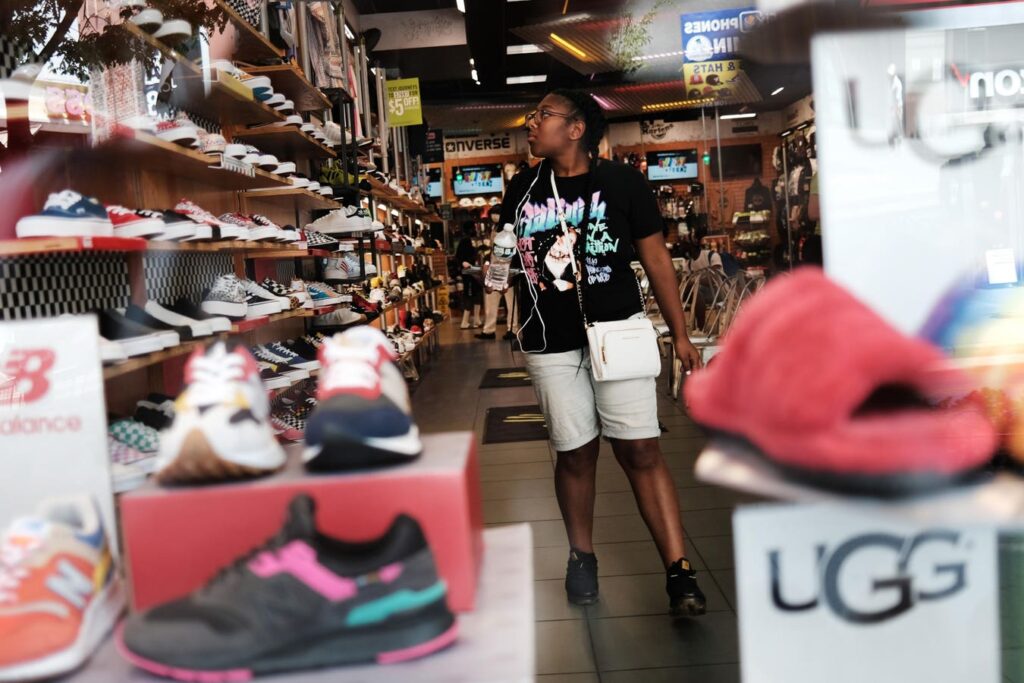NEW YORK, NEW YORK – A person looks at sneakers in a store in Brooklyn
Getty ImagesIf fashion is a language, sneakers are how many in the streetwear community speak. Now, the sneaker market faces a shocking reality as Trump’s tariff policies drive prices through the roof. With the U.S. imposing duties on imported footwear, especially from China where lots of sneakers are made, consumers may soon feel the sting on their feet and their wallets with a 30% tariff increase.
The Breakdown You Need To Know:
CultureBanx noted that prices will rise substantially as brands adapt to this new economic landscape and the numbers tell a stark story. Athletic footwear and apparel giant Nike produces about 800 million pairs of shoes each year and sells 42% in the United States, CNBC reported. The company could pay up to $3 billion more in taxes annually.
Nike has announced price increases of $5 on footwear priced between $100-$150 and $10 on sneakers over $150 that started June 1. Some of the most sought-after models face bigger price jumps. For example, an Air Jordan 1 High OG that used to cost $180 might soon reach $200-$215, a $20-$35 increase, according to Nike Shoe Bot.
Sneaker culture, deeply rooted in streetwear and music, has evolved into a global resale market estimated at $10.6 billion in 2022, and could reach a revenue of $51.2 billion by 2032, according to Market Decipher. The days when you could easily flip Jordan sneakers for triple the retail price might be fading, but rare releases that people really want could become even more valuable.
Sneaker Supply:
These higher import taxes on Chinese-made shoes will create problems for everyone who buys sneakers. Some people have started hoarding sneakers before these predicted price hikes take effect to save money. Right now, limited-edition sneakers sell for 200-1000% above retail prices, according to Cross x Over.
BMO analyst Simeon Siegel puts it simply “it’s rare to see this broad of a price increase”. For Nike, the company has kept its iconic Air Force 1 sneaker at the same price, but most premium models will cost much more. A study by Trade Partnership Worldwide for the National Retail Federation found that a $90 pair of sneakers could go up to between $106 and $116 after tariffs.
Retaliatory Tariffs:
Major athletic brands have moved their production away from China in the last decade. However, they remain vulnerable to these tariffs. Nike and Adidas make most of their products in Vietnam, the Business of Fashion noted, which could soon see a 46% tariff rate in July. This creates a multibillion-dollar challenge for Nike since most of its goods come from Vietnam and Taiwan.
A 10% tax from China on American imports creates even more complications. This countermeasure could hurt the competitiveness of American manufactured components shipped to China. In turn, Chinese consumers might turn toward domestic brands like Li-Ning and ANTA, which remain unaffected by these tariffs.
Situational Awareness:
Sneaker collectors and casual buyers must now adapt to these market changes. For communities where sneakers are a form of cultural currency the retaliatory tariff stakes are high. Higher retail consumer retail costs aren’t just price tags, they’re often seen as access points. Whether it’s a kid flipping Jordans online to fund college, or a creative using kicks to tell cultural stories, tariffs can be a silent barrier.
Read the full article here


